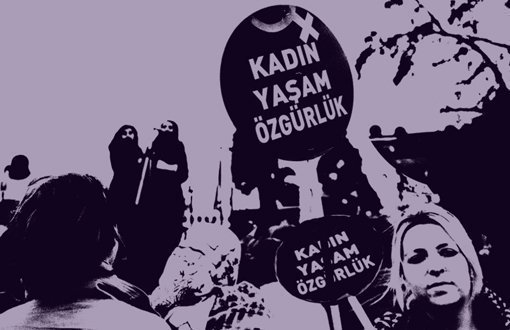Click to read the article in Turkish/Kurdish
According to news reports that bianet compiled from local and national newspapers, news sites and agencies, men killed at least 14 women and one baby; raped eight; forced 10 to sex work; sexually harassed 15; sexually abused 39 girls; inflicted violence on 46 women in March.
In addition to these murders, perpetrator of a murdered woman couldn’t be identified. Four women allegedly committed suicide. Two women were found suspiciously dead.
Three men threatened the women on whom they inflicted systematical violence, with death. One of these three men had severely injured his wife in the past and a lawsuit was brought against him; another one wasn’t arrested even though there was a jail term of 15 years issued for him, he wasn’t arrested again despite his threats.
Trans women constituted 7 percent and refugees/immigrants constituted 11 percent of 83 women who were subjected to violence by men.
Men killed at least 52 women and five children; raped 22 women; harassed 45; forced 166 women to sex work; sexually abused 87 girls; injured 113 women in the first two months of 2018.
Refugee/immigrant women. In March 2018, a refugee/immigrant woman was killed; three were raped; three were forced to sex work; two were subjected to violence. A Syrian woman, an Azerbaijani woman and a Kirghizistani woman were raped. Passports of a Kirghizistani woman, an Uzbek woman and a Turkmenistanian woman were seized and they were forced to sex work. Two Syrian women were subjected to violence, one had lost her 2-month-old baby as a result of this attack. | Trans women One trans woman was killed. One trans woman was found dead at her home. Two trans women allegedly committed suicide. Five trans women were subjected to violence. Iranian A.K. (27) murdered Azerbaijani sex worker trans woman Kristina. Trans woman named Nefes was found dead at her home in Ankara. Two trans women allegedly committed suicide in İstanbul and İzmir. Both women were being threatened by their families. Five trans women were subjected to violence in Adana, Ankara, Samsun and İstanbul. Four of the perpetrators were male strangers, one was a police officer. Only the murder suspect was arrested. |
Murder
Men killed at least 14 women, four men and a baby in March.
Half of the women were killed by their husbands.
Seven women were killed by their husbands; two by boyfriend; one by ex-husband; one by brother; one by a man whose marriage proposal was rejected by her daughter; one by rapist; a sex worker by client.
78.5 percent of the murders were committed with firearms.
Six men killed with rifle; five with gun; two with knife; one by choking to death.
One of the murders were committed despite protective order. Three killed women had filed complaint numerous times and but no protective order was issued.
28.5 percent of the women were killed for attempting to divorce/break up, or rejecting proposal to get married or recommence the romantic relationship.
One of the murderers got out of prison and then committed the murder.
Five men committed suicide after the murders. Two men turned themselves in after the murders.
The cities where the femicides occurred are Adana (1), Ankara (1), Antalya (1), Ardahan (1), Denizli (1), Edirne (1), İstanbul (3), İzmir (1), Malatya (1), Maraş (1), Ordu (1), Sivas (1).
Rape
Eight rape incidents were covered by the media in March.
38 percent of the raped women were refugee/immigrant women from Syria, Azerbaijan, Kirghizstan.
Two women were raped by men who identified themselves as police officers. One woman was raped by a police officer who took the woman into his vehicle on the pretext of taking her home. One woman was raped by boss; one by coworker; one by boyfriend; one sex worker by client.
Judicial processFive of the rapists were arrested due to rape, one was arrested due to another crime. No judicial process about the other two was reported in the media. |
Sex work by force
10 women were forced to sex work in Antalya, Adana and İstanbul. Three of the women were not citizens of Turkey. (Kirghizstan, Uzbekistan, Turkmenistan)
Judicial process24 of the 32 perpetrators were arrested; four were released; two are on the run; judicial process about the other two was not covered by the media. |
Harassment
Sexual harassment incidents against 15 women were reported in the media in March.
One in every three women were subjected to harassment on public transportation vehicles.
73 percent of the women were harassed by male strangers.
11 women were harassed by male strangers; two by superiors at the workplace; one by lawyer; one by a man who is in conflict with her husband.
Two of the harassers had criminal record of sexual harassment in the past.
Judicial processSix of the 14 harassers were arrested, one was released to be tried without arrest; two were released on probation. No judicial process was covered about four harassers. In one harassment incident, harasser's elder sister accused the woman of theft, the woman was detained and released on probation, no legal action was taken against the male harasser. |
Child abuse
Men sexually abused at least 39 girls in March. Two of the girls were with disabilities.
26 percent of the children were abused by teachers and school staff.
12 children were abused by male strangers; seven by teacher (six of whom were religion teachers); one by school principal; two by cleaning staff at school; one by owner of market near the school; two by neighbors; three by market owners in the neighborhood; one by assistant bus driver; one by friend; one by friend of her cousin; one by friend of her boyfriend; one by ex-boyfriend; two by father; one by her elder sister’s ex-husband; one by a man whom she knew on social media; two by men they knew.
15 percent of the abuse incidents came to light thanks to children telling their families. A teacher revealed an incident of abuse done by school cleaning worker. It was stated that the teacher informed the school principal of the incident twice, the principal didn’t take any action and consequently the teacher filed a complaint to district national education directorate and gendarmerie.
Violence-injury
Men injured/inflicted violence on at least 46 women in March.
Five of those women were trans, one woman was a refugee from Syria. At least 20 percent of the women were severely injured.
Of the perpetrators who imposed violence on 26 women, two were police officers and one was chief public prosecutor’s office.
Two women were subjected to violence despite protective orders. Four women had filed complaint numerous times but their complaints weren’t taken seriously.
10 percent of the women were subjected to violence for attempting to divorce/break up or rejecting to recommence the relationship.
One perpetrator left the prison on permission, imposed violence on his mother to withdraw her complaint, and then returned to prison.
54 percent of the women were subjected to violence by their partners or ex-partners.
One woman was subjected to violence by opponent team’s coach; two by their fathers; two by husbands of religious marriage; 10 by husbands of official marriage; four by ex-husbands; two by ex-boyfriends; one by a thief who broke into her home; one by harasser; one by neighbor; one by haircutter; two by fiancees; one by her son; one by her student; one by police officer; one by her boyfriend; one by a taxi driver; one by a male friend; one by her university lecturer; eight by male strangers. Acquaintance of women with men in four incidents wasn’t reported in the media.
23 women were battered; seven were injured with knife or sharp object; five with firearms. One man threw a bottle on the woman’s car, one fired on her home and threw molotov cocktail on her car; one man tried to make the woman swallow chemotherapy drugs and forced her to commit suicide and then battered her; two men kidnapped women; one man took a woman hostage; one raided the dorm where she stayed; one imposed verbal violence in the street.
ExplanationThe bianet Male Violence Monitoring Report only covers women who lost their lives as a result of male violence. We do not take include any violence cases or crimes that are not gender-based. Throughout the year, we keep track of unidentified murders and suspicious deaths of women in separate monthly tallies but do not add them to the number presented in the headline. At the end of the year, we examine these cases of unidentified murders and suspicious deaths to determine whether the crimes were gender-based. In time, when we come to the conclusion that a crime is gender-base, we include it in the end-of-year tally. We do not include any murders in the reports that are committed by people with psychological disorders (such as murders committed by people with schizophrenia). We include suicide or suicide attempt incidents in the tally only if the woman was subjected to violence/systematical violence in her past. We cover these suicide incidents in a separate category and do not add suicide cases to the number presented in the headline. In addition, we don't include femicide cases that occur in a mass murder in which the woman was not directly targeted under the condition that the debated incident is not gender based either. For example, following case from June 11, 2017 was not included in our male violence report: * A.K. (27), a rancher in Konya province killed his relatives Bekir Kıran (80/male), Mustafa Tokat (80/male), Meryem Tokat (79/female), Hamit Tokat (51/male) and Mehmet Tokat (64/male) with a barreled-gun. He was caught on the way home after committing the murders. It was reported, that A.K. had schizophrenia and considered the villagers responsible for the death of his father, who had lost his life after a heart attack. The occupational groups mentioned in the report, only cover cases in which the occupations have relevance for the act of violence. * Example: "The expression "x% of the rapists were drivers",imply that the woman was raped by the driver of the (public) transportation vehicle she used. |
(ÇT/TK)







.jpg)



